Essential Tenkara Flies & Presentations
It’s not always easy to look at the different types of tenkara flies and know right away what presentation tactics they are meant for. Many people in the West think that all tenkara flies have reversed hackles (just as one example of a lack of information). So, when you look at the wonderful journal of examples that Yoshikazu Fujioka has personally collected over the years, you realise there are MANY different styles of patterns in Japan. I’ve done my best on this page to begin to match some of the core fly design features to presentation tactics that help you get the best out them. Finding out about those links can add some interest to your experiments on stream – and even help you to catch more fish if you want to.
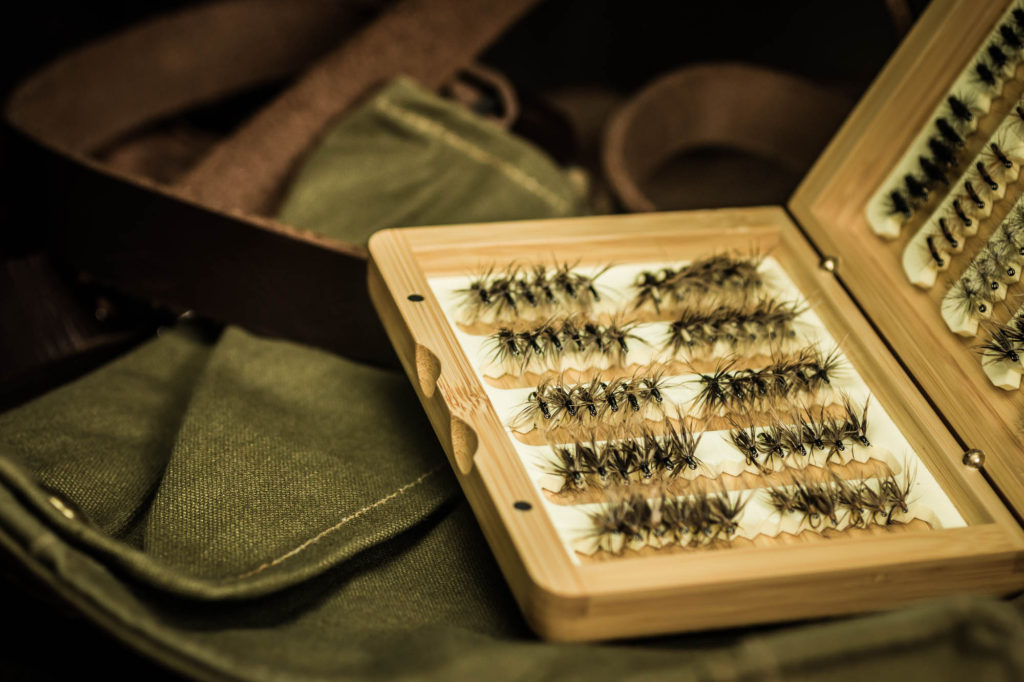
Either way, by the end of this article, you’ll know a ton of tricks, tactics and fly design principles that are pretty common knowledge for top Japanese anglers (but which are almost completely unknown in the English-speaking world). You can use this to cut through a lot of the conventional information/myths on tenkara flies…from “You need different fly patterns for each insect and each stage of that insect’s life to avoid being caught out” through to “Most tenkara Japanese anglers only use one fly pattern“. I’d argue with both of those statements – while still fully accepting that it’s really OK to follow those paths if you enjoy it.
This isn’t about telling you what you can and can’t do…
Instead, (if you want me to) I’ll show you how SIMPLE tenkara flies are incredibly adaptable – and why understanding the different designs and materials will let you tackle a huge range of rivers around the world with just a handful of basic patterns. In other words, I can help you build a fly collection that will catch fish under a ridiculous range of conditions, hatches and locations. If you want the COMPLETE lowdown on how to use them…of course we just published a book on that too.
Here’s just one example of a simple, and incredibly effective, tenkara fly (or kebari) that I love to tie and use:
You Never Know When You’ve Already Done Enough To Fool a Fish
Even if you think we missed our target with the fly set, you might be interested in the reasons I also wanted to call this blog post “Why Close Copy Fly Tying Really Misses the Point for Fly Fishing”…Now, before you get the wrong idea – I’ll come right out and say that I think close copy tiers are awesome (and I even enjoy tying more intricate stuff from time to time)…
But in terms of FISHING, I believe it is actually a fairly crude “shotgun” approach.
What I mean is, it makes the mistake of believing that the features of a fly that we humans use to say “that looks like a mayfly” are necessarily the same cues that fish use to tell “food” from “debris”.
I call it a shotgun approach because it is a case of including as many details and features as possible – in the hope that the right triggers and cues to get a fish to eat are in that mix somewhere. Instead, in 2014 I started to try to make and teach a way to design and then use particular flies, in the right sizes and using the right presentations to give the best chance of success.
These are the decisions that excellent, successful anglers seem to make automatically all the time.
Whether it is modern competition anglers, the old professional North Country Wet Fly fishers (who needed to get a profitable catch onto the goods train to market before it left the station) or professional tenkara anglers, fishing for survival; all of them rely on great choices in the use of simple, impressionistic fly patterns.
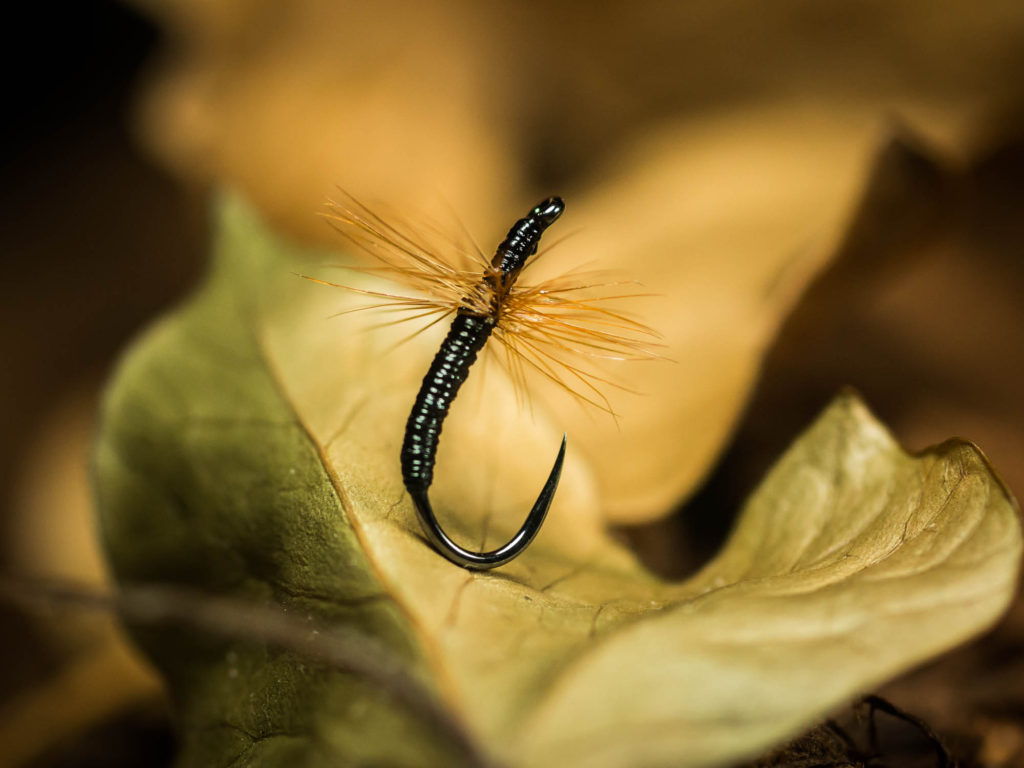
Now all of those “schools” of fly fishing practitioners have a couple of major things in common:
- They all need to catch fish effectively as a bottom line result (having a bit of sport and tales of the one that get away wouldn’t cut it)
- They all use impressionistic, highly FUNCTIONAL flies
- The flies they use are blended seamlessly with the presentation techniques that the angler uses
Tenkara is an Ideal Model for Westerners Because its History and Subtle Methods are Unfamiliar
Thankfully, now that we have the luxury of making fly fishing our hobby, Catch & Release dominates the ethics of the best fly fishers in most parts of the world today. That transition to a hobby is also especially fascinating to me in terms of tenkara. It is a brilliant model because it begins from the idea that the way you use your fly is equally/more important than trying to design different fly patterns to produce different imitations. I reckon that is both different from most anglers’ idea of “matching the hatch” and also probably a big clue to how the best anglers achieve their success.
Also, up to now, there has only been a very narrow strand of tenkara’s rich and (if you want to get deeply into it) highly technical presentation methods. That means it comes with a bit less “baggage” and can help us re-examine our own more familiar methods too. It lets us get to grips with the mechanics of what makes a FISH take a FLY (regardless of the type of rod you are using).
So I wanted to use what I know about the biology of fish – and other visual-predators’ – behaviour to understand the choices that great anglers make. I also wanted to make a successful system that is easy for anyone to pick up and learn too. Overall, I am ESPECIALLY interested in the link between the physical characteristics of simple flies and how they can be matched to brilliant presentation methods (This was the central idea behind the “How To Fool Fish With Simple Flies” Print Book that I wrote and JP did amazing photos and materials documentation for).
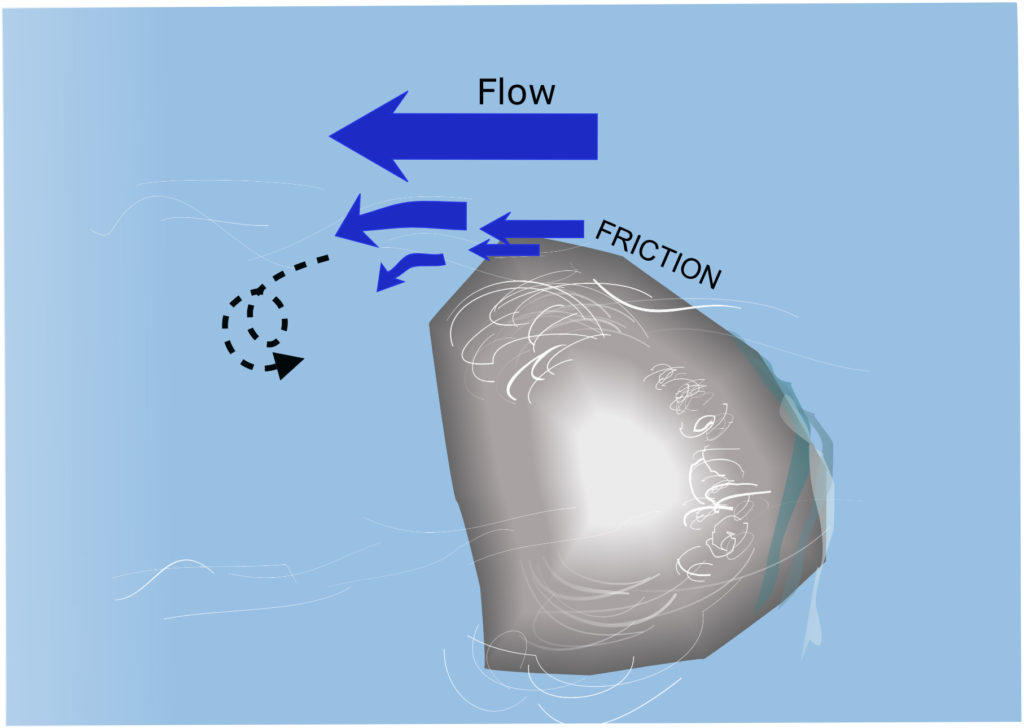
Here, again, tenkara is a brilliant method to study; because of the rich range of presentation tactics (often with specific names) based around unweighted, fairly scruffy, impressionistic flies and a deep understanding of river current features.
Through researching the book and annual visits to Japan, JP and I were approached to design a commercially-available set of kebari (Japanese tenkara flies) that could be picked up and matched to the different, distinctive tactics of Japanese tenkara.
John took the lead on tying up some beautiful samples based on the range of physical characteristics that we’d identified through our experiences and research – and that I could directly match to the presentation tactics detailed in the book.
The difficulty (and the power) is always found in simplicity – so don’t be fooled by the modest selection of patterns that make up the Discover Tenkara Kebari range (tied on high quality hooks to exacting standards). Each one is designed to fit neatly into its “sweet spot” presentation tactic and the simple colour range lets each pattern cover a wide range of conditions, contrast and imitation functions.
There are even some tweaks to the names for our range that we have been able to add following our most recent trip to Japan. Here’s a quick introduction to the range, with more detail coming in our other material such as these demonstration Videos:
The Discover Tenkara Kebari Selection
Now for the patterns themselves. We’ve put together a a simple set of flies that you can combine with tenkara tactics to cover a huge range of conditions. Aside from being just impressionistic enough to be recognised as food, changing the size of the profile and also the action of the hackle provides an incredibly adaptable set of flies. With just three main colour variations, differences in water conditions and, if you feel it necessary, imitative body colours are easily accounted for.
Of course, the range of situations that you can cover just by varying size, body colour and hackle type suddenly becomes extremely broad. As a final adaptation, the inclusion of three dedicated tungsten “bead head” flies for achieving depth in more powerful flows also gives an added dimension of adaptability.
In Japan opinion is divided over whether single, bead-head flies are recognisable as “tenkara” (they tend to be used in large “Honryu” rivers when approaches using unweighted flies are not working on a given day). However, our fly sets – while designed to give arm you to fish with tenkara tactics – can also be used with great success for traditional wet fly, dry fly (when greased up) and even European Nymph Tactics. So in this respect it is really more important that you know about all the techniques so you can pick the right fly for the job (and be able to tell folks how you caught all those fish afterwards!!).
The following are all Wet Flies (even the stiff-hackled patterns) and come in three body options; Black, Cream and Peacock…
Futsuu Kebari: “Regular” rooster hackled kebari, feather barbs generally standing perpendicular to the hook shank)
These bad boys are the real “best kept secret” of Japanese tenkara anglers. Their ability to be cast very accurately comes from their relatively small profile and because the hackle is highly symmetrical around the hook shank (with no tails or wings to make a fly spin like a propeller). This makes it possible to drop incredibly accurate casts into likely-looking current seams and back-eddies or soft-spots in the current. The stiff “disk” of hackle also helps to “grab” even quite gentle currents which flow away from the angler. With light, level casting lines, the savvy angler can use this combination to both anchor a fly in a likely feature – at the same time as really stretching out their casting line WITHOUT letting it touch the water. There’s more on that in This Article on uber-specialised Nylon Level Lines.
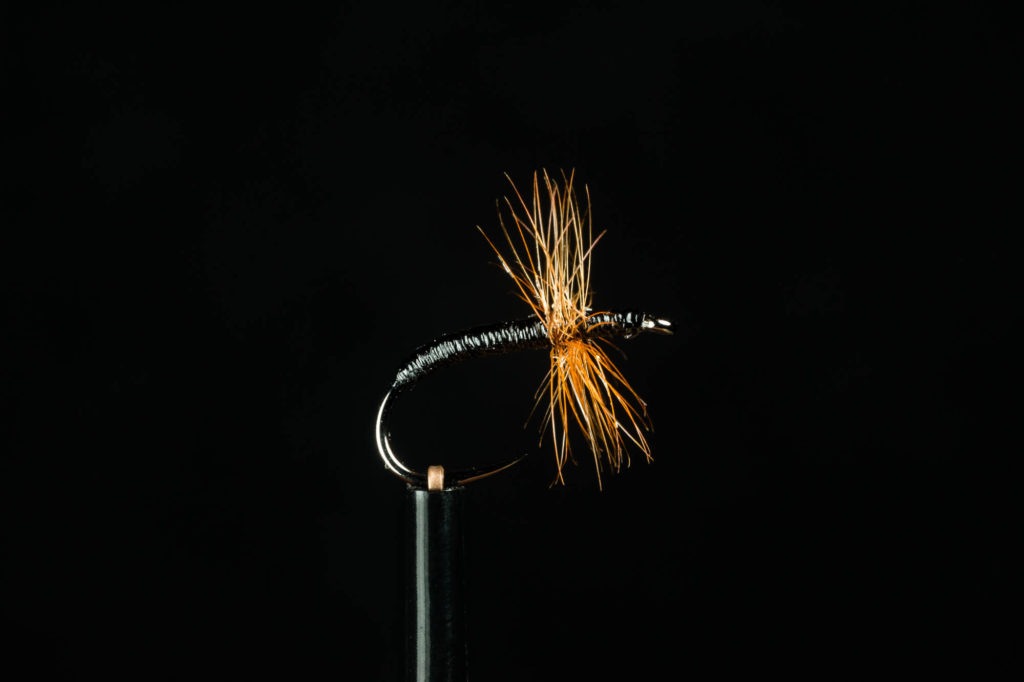
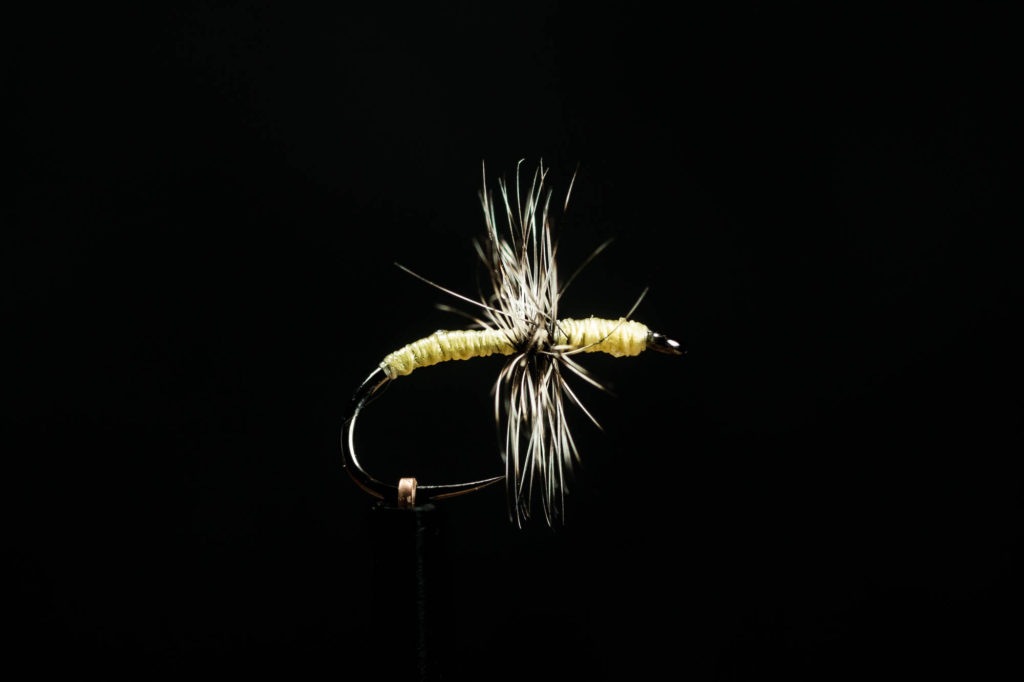
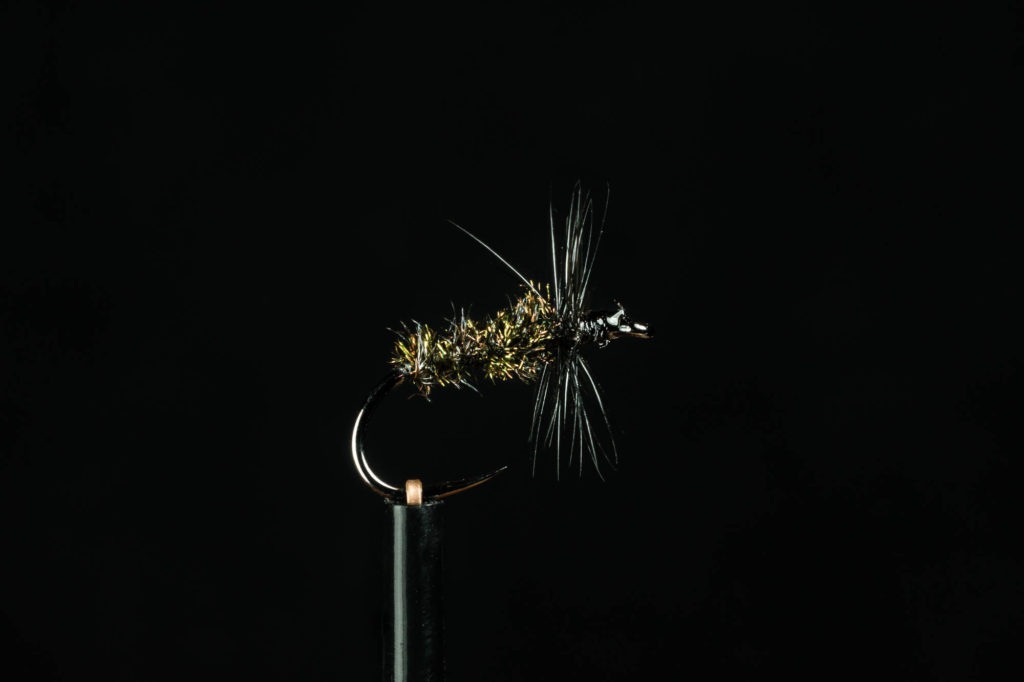
Stiff hackled wet flies can also be deadly when used to deliberately create a disturbance in the water when manipulated. This could be sub-surface (to create a kind of “popping” effect on the fish’s lateral line that it uses to sense vibrations. Or it could be the wickedly effective imitation of struggling insects/buzzing wings of a crash-landed fly using the tactic we’ve nick-named “Ashtapa-zuri”. There’s a full article on the Ashtapa-zuri manipulation here.
And you know what, if you want to fish western dry fly tactics, you can go ahead and smear a thin layer of floatant on these patterns and they’re absolute dynamite too…I think they are basically the Universal Soldiers of our fly boxes. They are flies with a “Can Do” attitude.
Jun Kebari: “Normal, Backward-angled” soft hackled kebari
These are the ones that folks are sleeping on right now…And it is a huge mistake. One the one hand they might be overlooked because they appear quite similar to familiar, soft-hackle wet fly patterns (and familiarity breeds contempt). On the other hand, the poster-boy “sakasa” hackles probably grab a lot of the attention of anglers because of their seductive “pulse” when you tug on your casting line.
Here’s the thing though, right now there is huge emphasis in the North Country Spider community on super-sparse patterns. The hackles are tied with the absolute minimum of barbs sticking out and the bodies are generally incredibly sparse and minimal too. Those flies are fantastic – especially in conditions where the water is lower and clearer. But when you look at actual examples of original North Country flies (and there are a reasonable number of them still in existence), they can often be tied with a really generous hackle. Their profiles can also cover a range from slim to more substantial. So that is one area where anglers are missing a trick from the past.
The second overlooked source is the group of Japanese tenkara anglers who know very well just how effective these “jun” hackled wet flies are. They have a natural mobility when dead drifted (for instance when cast upstream – with the head pointing downstream – and the cone of the hackle facing into the flow…). Then there are specialists like Shin Takahashi (a phenomenal traditional tenkara AND European nymph angler – who sometimes blends high-level tenkara techniques with European competition flies) have even designed special tactics using jun hackled Japanese kebari. Those tactics exploit the fact that jun hackles tend to close when pulled and open a little when paused especially if they are encouraged to sink a little bit on each pause. That motion is very attractive to fish.
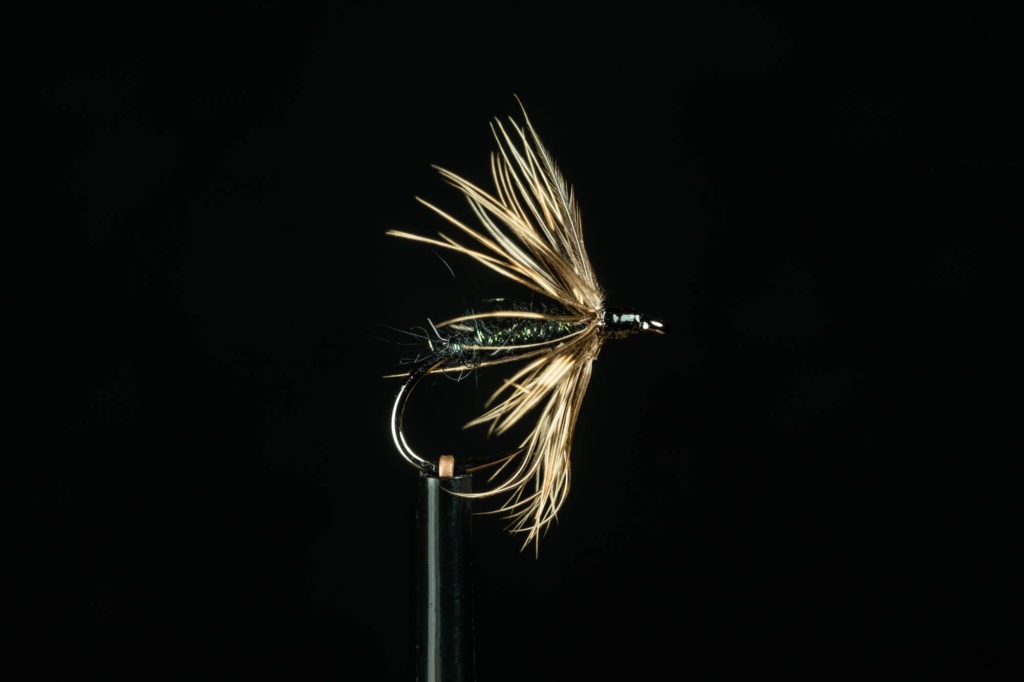
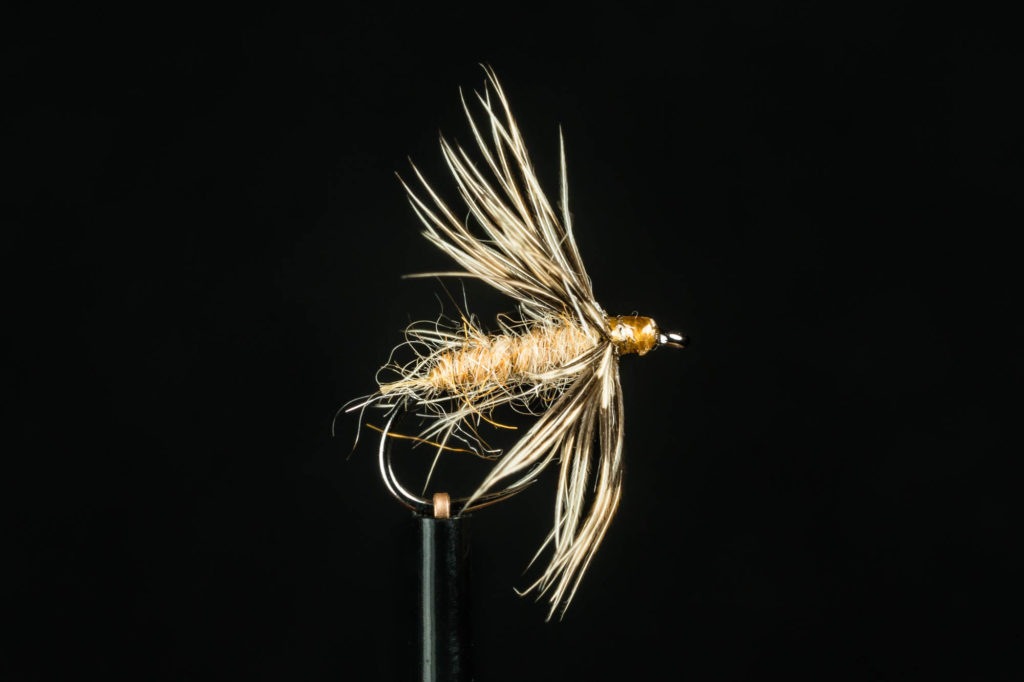
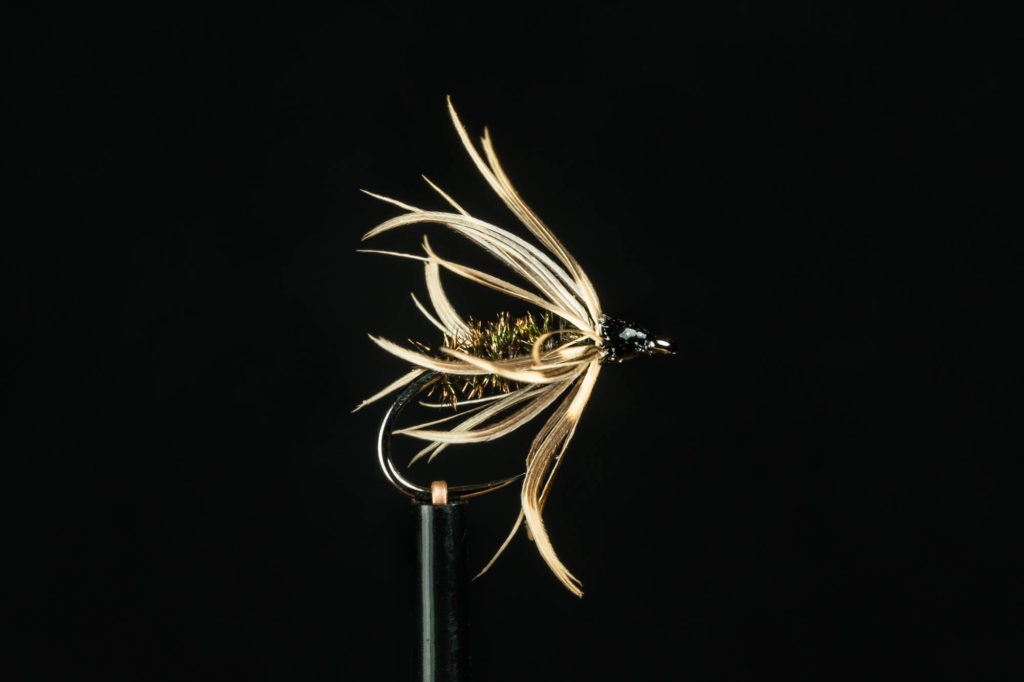
Look out for demos of those special tactics developed by Takahashi san in our video media…PLUS – don’t sleep on these jun kebari, there’s a good reason that they are the secret weapon of a number of Japanese anglers (and just wait until you try the cream-bodied ones in a caddis hatch).
Sakasa Kebari: “Reverse-angled” soft hackled kebari (note, some tiers only class more extreme “funnel” shaped hackles as true “sakasa” style…)
Probably the most iconic tenkara flies and certainly responsible for tempting folks to turn regular western flies into “Japanese flies” by reversing their hackle! If you get the right hackle material, this can work well, but in many cases the original feather on the Western patterns would have been better suited to a Jun tying. There has to be just enough density combined with the right amount of “give” to get a hackle to come to life in the reverse orientation. WIth “sakasa” meaning “reversed” and “kebari” meaning “fishing fly” (or literally “feathered hook”), it is obvious how these flies got their name.
We’ve spoken on this page about how a lot of Japanese anglers will include sakasa patterns in their fly box – even though it only makes up a minority of flies in use in Japanese tenkara. This is much like the way most of us will carry a green-drake/classic mayfly pattern in our western boxes. Both sakasa kebari and green drakes have their particular “job” – and are very good at it. That still doesn’t mean that we only carry green drake patterns in our western fly boxes…In fact, most dry fly patterns are not green drakes…But that doesn’t make green drakes unimportant.
What you need to know about sakasa kebari patterns…
First of all, some (very prominent) folks in Japan like Yuzo Sebata only really recognise the super-bushy, super-exaggerated cone-hackled flies as true sakasa patterns. These are often used in very powerful flows and “pulsed” against those brutal currents (either on or below the surface). For that reason, the hackles need to be very robust and have a very pronounced forward slant in order to create the classic pulsation movement and have some ability to resist being washed back flat against the hook shank.
If you have a slightly broader definition of these flies – where the natural convex cone of a soft game-hackle is tied so that it faces forwards towards the eye of the hook – then here are some useful characteristics you can use to catch more fish…
When tied long, the “dish” hackle is fantastic at picking up or “receiving” flow as Go Ishii says. This is a core part of the tactic of fishing dead drift DOWNSTREAM – so that the fish see your fly before they could possibly see any tippet, casting line or rod tip. By now I hope that you are starting to see what I mean by matching the FUNCTION of each fly design to the best ways to use them
Another point that Kazuo Kurahashi (Kura-san) makes is that, because hooks tied onto tippet naturally want to sink “bend first”, a reverse-hackled fly will often be a bit more streamlined than either a “jun” or a “futsuu” hackled wet fly as it sinks. You can use this knowledge to choose your sink rate for flies depending on what depth the fish you are targeting are feeding at.
Finally, as mentioned earlier, even when the barbs are swept back beyond perpendicular, the natural curve in the feather makes it “want” to spring back after you pull the fly. Because of this, it can make for a very tempting impression of life when you gently tug the line by tiny movements of your rod tip.
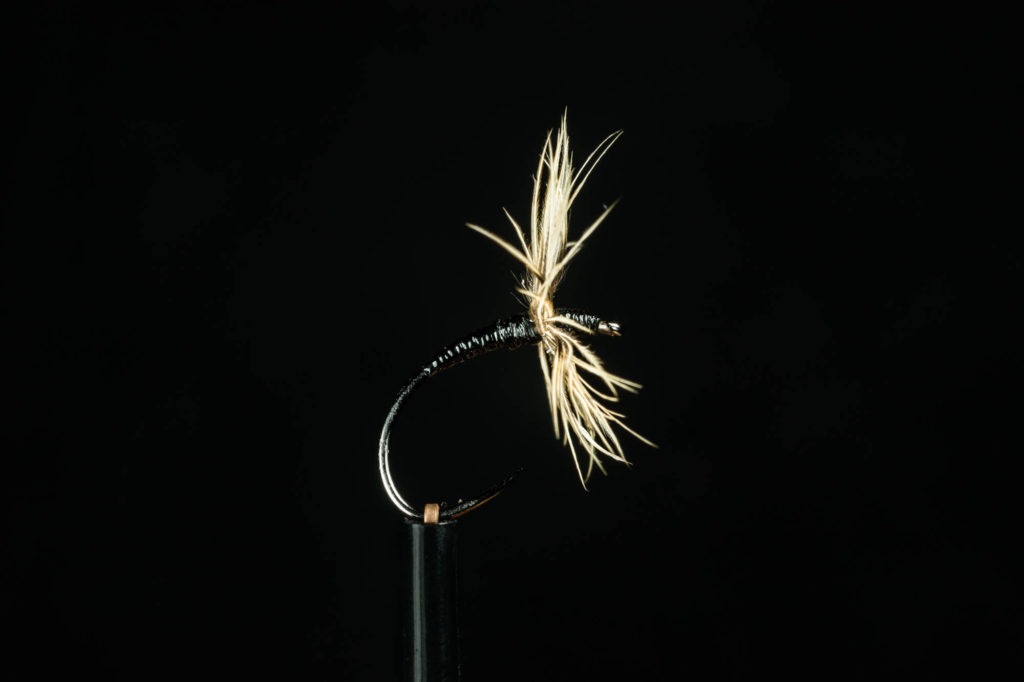
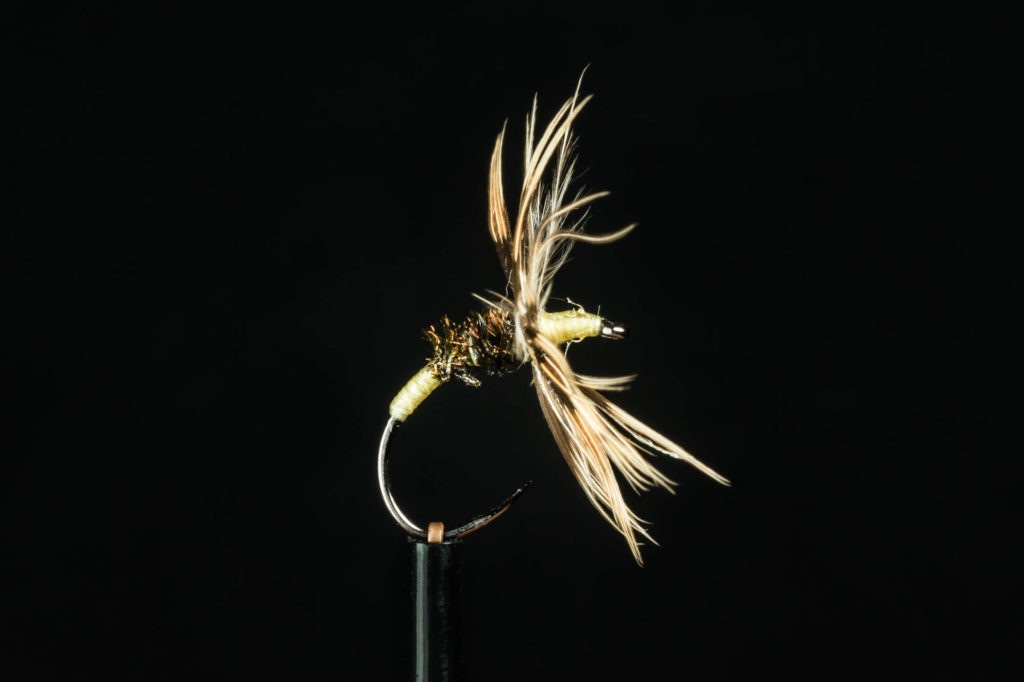
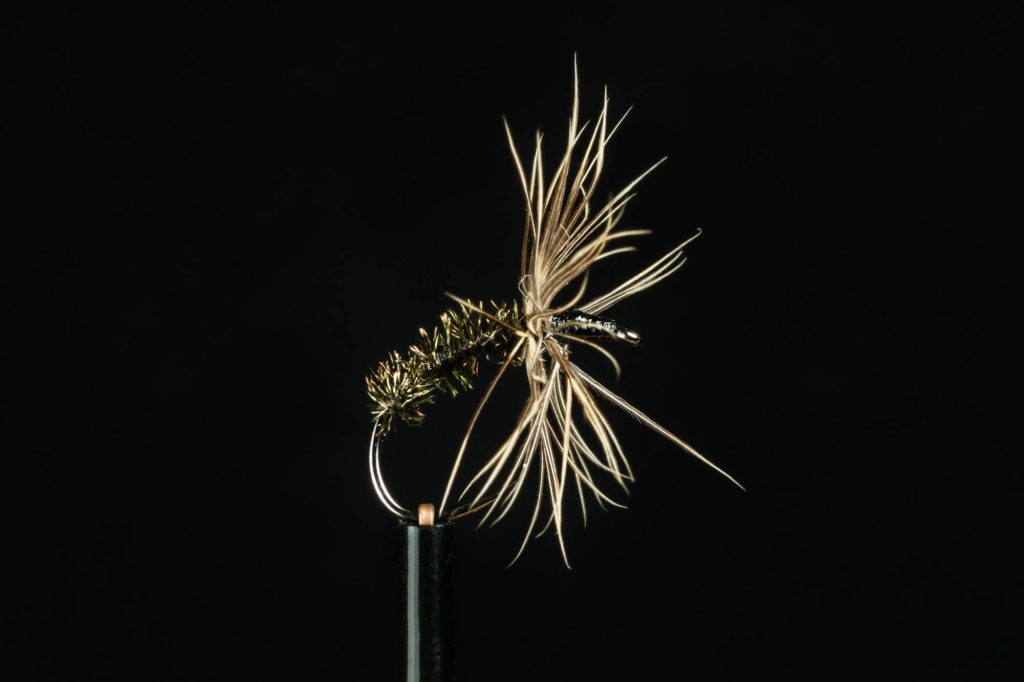
Extremely popular and, when matched to their ideal presentation methods, the reverse hackled “sakasa kebari” are worthy members of any wet fly collection.
We have termed the weighted patterns in our range “Honryu” kebari…
This is simply because they tend to be more appropriate to the larger, deeper and faster honryu (main) sections of Japanese rivers. BUT, all of the above styles of kebari are also used on “honryu” rivers. It is just our own convenient arrangement to label them like this for an easy shorthand reference.
As well as the very obvious applications for all styles of Euro nymphing (short-line and longer-line included), these kebari can be used in some of the heavily-manipulated presentations of “Honryu Tenkara”. Typically this will take place in powerful, deep sections of river. Often the aim with weighted patterns will be to cast them on a long line (generally fluorocarbon because of its density and the desirability of sinking the tip part of the casting line).
Tippets for long line/weighted fly honryu tactics are also longer than for regular “keiryu” tenkara (where you usually try to keep all the casting line off the water). The longer tippet gives some separation between the disturbance of the casting line and the fly.
The longer casting line (and the habit of fluorocarbon to sink more easily than less-dense materials) means that the desired “flat” plane of pulses of the weighted fly are easier. This is one of the main differences to most euro-nymphing presentations – and is more similar to the presentation of streamers in rivers on western fly rod and reel. The difference here is that the longer rods (4 to 5-m in length) allow for sophisticated control of the casting line over and around complex, powerful currents.
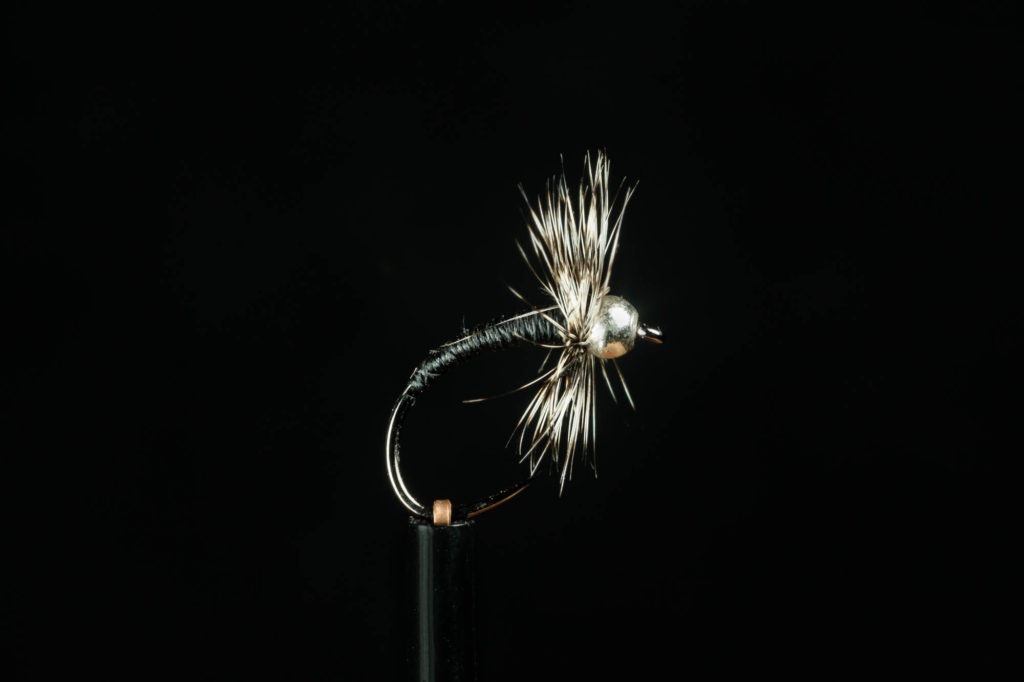
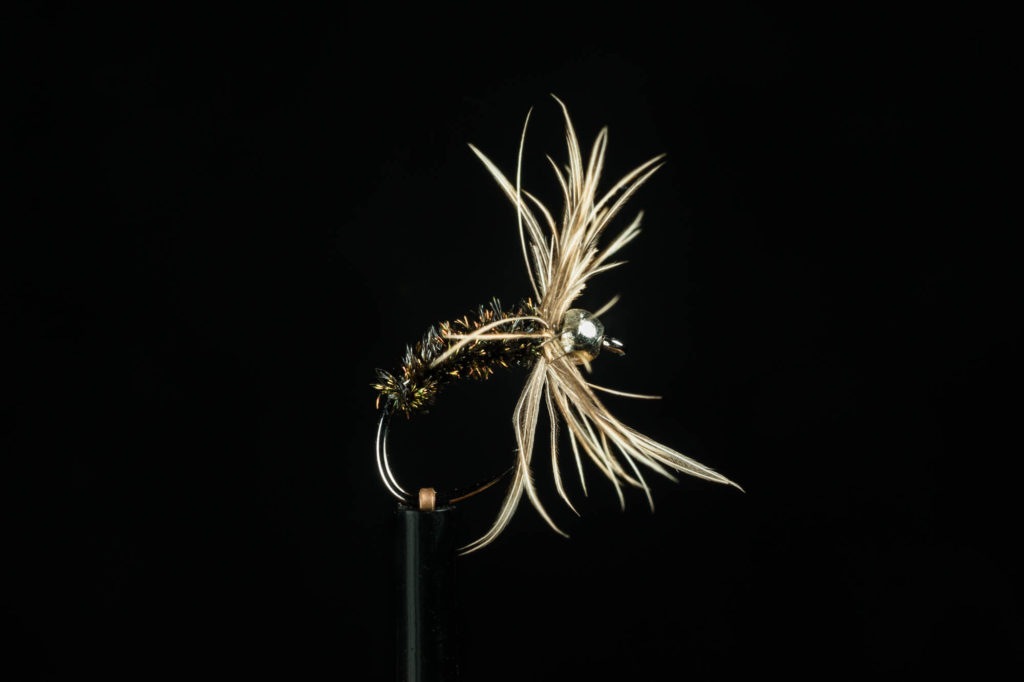
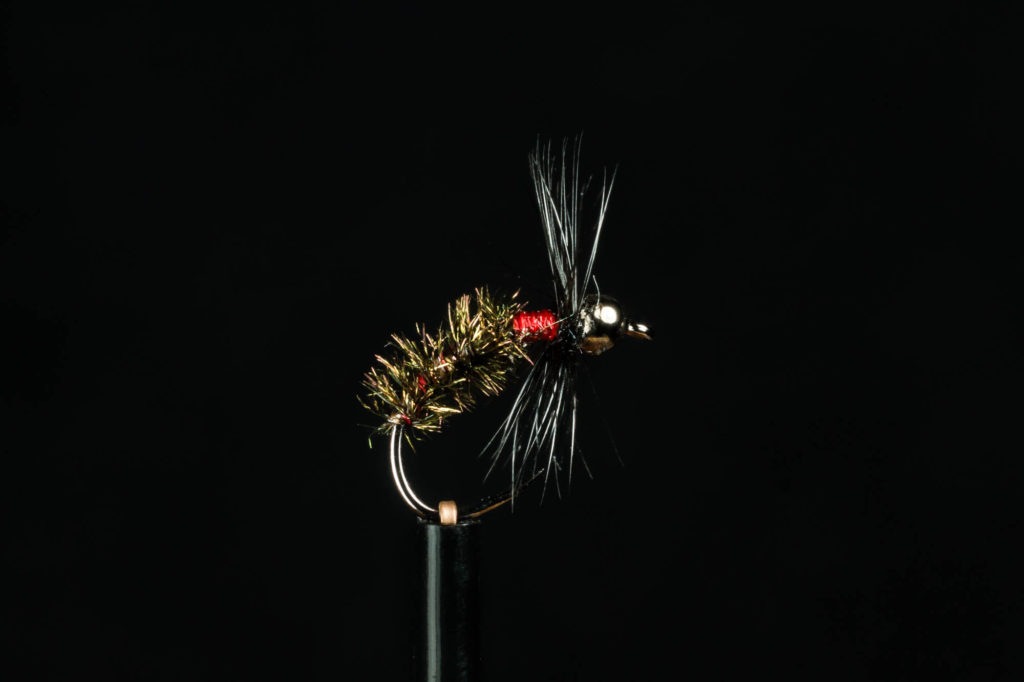
We’ll keep producing more details on the characteristics of these kebari and how you can fish them both in our free and our premium media. You can see a full range of the premium downloads – including Japanese angler masterclasses with on stream videos and illustrated written lesson breakdowns in our:
You’ll find a comprehensive range of onstream masterclasses from Takahashi san, Go Ishii, Kura-san and much more (including European nymph fishing and fly tying courses) on there.
In the meantime, let me know what you think of this selection and also the idea of concentrating much more on the Function of flies than making photo-realistic copies of insects…
And if you know people who would want to see this; just share the page link with your friends.
Paul

I’ve had great success with the DT Futsu & Honryn flies, looking forward to learning where to use the Sakasa style. Tx
Awesome Neil, a little bird told me that you romped away with club ‘top rod ‘ on a recent fun day on your waters using what you’ve been learning with JP?
Wondering with all this angst about how the fly looks in dry air, perhaps the “look” in actual moving water from the fish’s point of view might be critical?
Oh it absolutely is how it looks ‘in use’ Joe, you are right. I’m also fascinated by how the materials actually ‘work’ in the water too. Do they go translucent? Are they very mobile? Do they lock into current seams and let you ‘anchor’ your fly in place? All very addictive stuff to play with.
Great pics! Good selection of flies
Thank you Bob! That’s really kind of you to say. JP’s photos of this commercially tied range and the examples given to us by anglers in Japan are absolutely lush. He even managed to make a few that I tied look presentable 🙂
Can’t wait for these to become available, they look really good. Thanks for all the tips and info you give, they’re really helpful, especially for a relative novice like myself.
Cheers Mike, I think you will really like our upcoming free youtube content on these styles of flies.
Paul
I did read about your (this) collection some times ago and I can agree totally. The tying style of this kind of flies is that what I use too. I like to use wool-bodies in grey, oyster and black. Sometimes I add a tag on my kebaries. A grey or black body with a white or cream tag is not as anticamouflage as a hot red or lime green one. This works good for me.
Awesome, thanks Eberhard – love the idea of a tag that highlights without spooking too much. Nice application of the anticamouflage slider concept outlined in the book 🙂 🙂 🙂
I agree very strongly with your thesis about imitation. I have been using a lot of Jeremy Lucas’ “Plume tip” dry flies over the last few seasons, and these minimalist little bugs, well presented, are very effective. Same idea, I think.
Many people confuse complexity with powerful thinking, in reality the power (and difficulty) is found in simplicity. If you can find the one big idea that explains everything…then you are really onto something. E=mc2 🙂
Great articles, very interesting and thought provoking. This last discussion goes back to the old adage ‘size and presentation to suit the conditions’.
Thank you Stan, it really feels good to think that what spills out of my head might actually be useful to you from time to time.
I’ve become very interested in how fish “see” flies or forage. While we don’t know a lot of detail about how fish see, we do know it is different for different species, especially open water slat varieties vs fresh. Here’s what intrigues me and hasn’t been addressed directly, apparently: Color is always both absorbed and attenuated in water, clear or not. Any thing red will appear black more than 8-10 feet awat by simple absorption of the red part of the spectrum, so a red fly looks black 8-10 feet away. Not so for blue or green. Lots to think about there. Also, any particulate matter in the water intensifies this effect. Next thing is UV. Fish can see colors in UV that humans cannot. Which ones? Who knows? Many of the materials and/or the dyes used in fly tying materials have strong UV reflectancy and probably domiante in fish vision while remaining invisible to us. Insects see primarily, if not exclusively, by UV and it is those UV colors that draw bees, for instance, to a particular type of flower. So, what color does thew fish really see when we used various materials to tie flies? Polarization of light is another subject. Humans can’t see polarized vs non-polarized light, but fish do! This increases contrast, for sure, so should we paying attention to the polarization and UV capabilities of our materials? I think so, but don’t know how. Certainly, many of the synthetic bling materials are strong polarizers, but how do we use this, if at all? Would it be useful to create a catalog of images of the UV reflectance colors of various materials? I can do this, if there’s an interest (I have cameras that can record in UV), but, again, how to utilize the information? Lots of areas of study still available. And precious little time to fish.
What a brilliant contribution Wayne. I have long been fascinated by UV perception since seeing photos of male birds (where females choose males based on visual cues) under human visible wavelengths and then Ultra Violet spectrum wavelengths that the birds can see. Quite extraordinary to see the patterns of plumage we can’t see, but the prospective mates can. I guess my particular interest in fly patterns and fish as visual predators is particularly focused on what fundamental factors of dimensions, movement and profile actually indicate ‘food’ instead of ‘irrelevant particle’ to a fish. As a second layer, what factors make a fish pick out one fly out of the cloud of natural food items are also of real interest. Anything that contributes some understanding of those two critical areas is gold dust to fly fishers. The wonderful thing is that this information is as likely to be found through practical fishing experience as it is to be found through formal science.
Is it the case that if they don’t look to complicated, are more simply made with the right key features, they have the freedom to move in more complicated ways ? That attract the fish’s attention?
To paraphrase the old Billy Crystal character in reverse – It’s not how you look, it’s how you move, and you move marvelous.
Hi David, I think that is a lot of it yes – but beyond that it is also how different physical characteristics can help you make your fly perform. So for instance, using a stiff hackle to deliberately catch the current and allow you to position the fly where the fish is by “sailing” it into position. Or, depending on which way the hackle is sloping – it will pulsate more on the pull or on the pause/sink part of a manipulated presentation.
Paul
Great teaser for the end of Season 1. Have really enjoyed following you and your guests this past year! Curious if your flies will be multiple copies of same patterns as it looks to be in the photo, or if you will offer the same pattern in a few different sizes?
Looking forward to Season 2.
Cheers!
Hi Michael, the flies will be sold in two sizes for each pattern variant. The main categories of backward-sloping soft hackle, perpendicular stiff hackle and forward-facing soft hackle will each have 3 body-material variations of pale, black and then irridescent peacock. The weighted Honryu patterns have their own unique variants. The size variants are 12s and 14s in terms of hook size – though the length of the hackle between different patterns also provides another significant layer of variation in size of the overall outline of each fly.
We’ll be fishing these patterns extensively to show their versatility in upcoming YouTube content.
Watch this space,
Paul
Hi Paul what are the Fulling mill hooks used in your Kebari range?
Hi Graham – the straight-shank patterns are on a FM “Grab gape” hook whereas the curved ones are on the FM Cz Nymph hooks 🙂
Paul